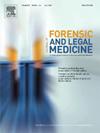告知治疗护理和法律程序的攻击案件涉及非致命的扼杀
IF 1.2
4区 医学
Q3 MEDICINE, LEGAL
引用次数: 0
摘要
背景:非致死性绞杀(NFS)是女性凶杀的主要危险因素。受害者可能出现在各种临床环境中。在本研究中,我们分析了NFS后报告的体征、症状和损伤。方法对170例NFS患者进行了临床检查,包括法医摄影。结果患者报告颈部疼痛(77.6%)、呼吸困难(60%)、头痛(55.9%)、喉咙痛(52.9%)和声音改变(47.1%)。76.5%的颈部损伤包括非点状挫伤(59.2%)、线状擦伤(抓痕)(25.4%)、颈部肿胀(12.3%)、点状出血(7.7%)和结扎痕(1.5%),23.5%的病例未发现颈部损伤。尽管通过统计分析进行了广泛的询问,但没有典型的NFS症状、症状或损伤的患者概况或任何体征的相关性。结论为协助NFS患者的治疗和法医证据收集,应记录患者的体征、症状和损伤情况。NFS后颈部未见明显损伤并不排除NFS。此外,可检测到的损伤可能表明患者的防御反应和/或多次使用武力。本文章由计算机程序翻译,如有差异,请以英文原文为准。
Informing therapeutic care and legal process in assault cases involving non-fatal strangulation
Background
Non-fatal strangulation (NFS) is a major risk factor for female homicide. Victims may present in a variety of clinical settings. In this study, we analysed reported signs, symptoms and injuries following NFS.
Methods
This is a clinical audit of 170 NFS victims who underwent a documented clinical examination, including forensic photography.
Results
Patients reported neck pain (77.6 %), an inability to breathe (60 %), headache (55.9 %), sore throat (52.9 %) and voice changes (47.1 %). In 76.5 % neck injuries were detected comprising non-petechial bruising (59.2 %), linear abrasions (scratch marks) (25.4 %), neck swelling (12.3 %), petechial haemorrhage (7.7 %) and ligature marks (1.5 %) with no detectable neck injury in 23.5 % of cases. There was no typical patient profile of NFS signs, symptoms or injuries or correlation of any signs, despite extensive interrogation by statistical analyses.
Conclusions
To assist with therapeutic care and forensic evidence collection following NFS, signs, symptoms and injuries should be documented. A lack of detectable injury to the neck following NFS does not exclude NFS. In addition, detectable injury may indicate a defensive response by the patient and/or multiple applications of force.
求助全文
通过发布文献求助,成功后即可免费获取论文全文。
去求助
来源期刊

Journal of forensic and legal medicine
MEDICINE, LEGAL-
CiteScore
2.70
自引率
6.70%
发文量
106
审稿时长
57 days
期刊介绍:
The Journal of Forensic and Legal Medicine publishes topical articles on aspects of forensic and legal medicine. Specifically the Journal supports research that explores the medical principles of care and forensic assessment of individuals, whether adult or child, in contact with the judicial system. It is a fully peer-review hybrid journal with a broad international perspective.
The Journal accepts submissions of original research, review articles, and pertinent case studies, editorials, and commentaries in relevant areas of Forensic and Legal Medicine, Context of Practice, and Education and Training.
The Journal adheres to strict publication ethical guidelines, and actively supports a culture of inclusive and representative publication.
 求助内容:
求助内容: 应助结果提醒方式:
应助结果提醒方式:


